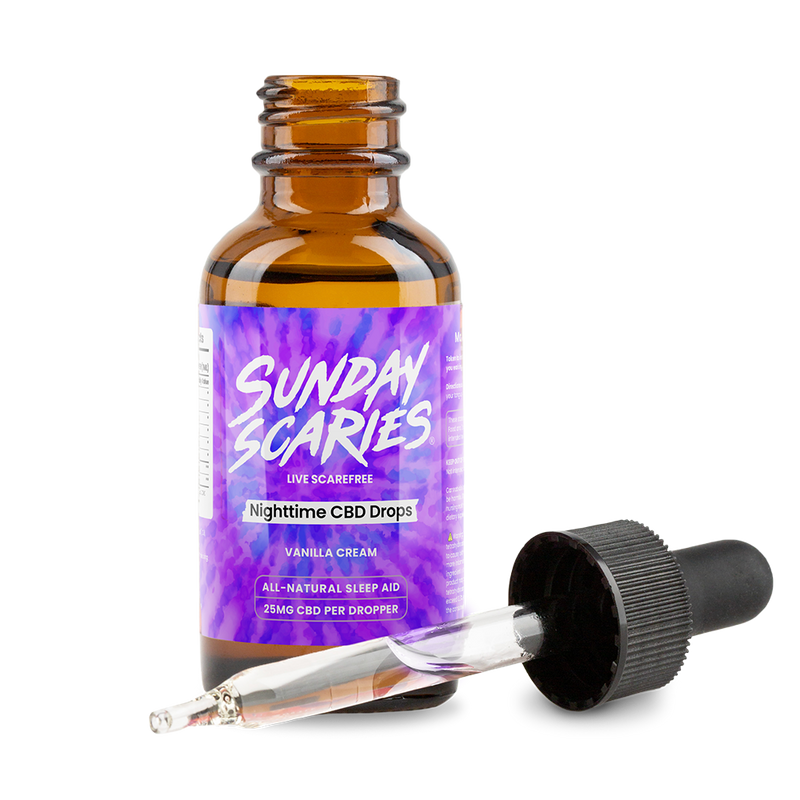
How to Avoid Workplace Burnout: A Comprehensive Guide
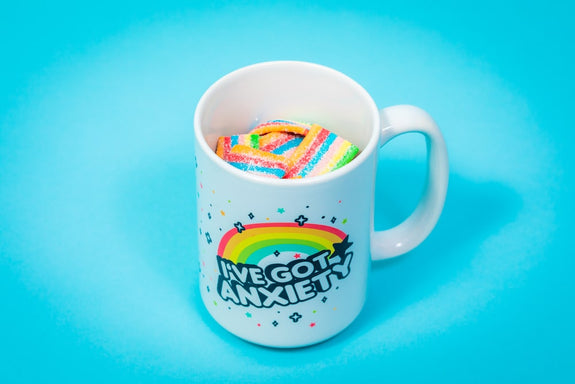
Workplace burnout, like a pesky mosquito, doesn't discriminate - it targets people of all ages and professions.
Can you believe it? A whopping 66% of full-time U.S. employees have felt the burn at some point in their careers.
Talk about a mood killer.
This not-so-fun phenomenon brings gifts like decreased productivity, high absenteeism, job role conflict, and sky-high turnover rates. Yep, it's a real party pooper for both employees and the organization. If you're a young professional on a career path who feels overwhelmed with work, don't worry, you're not alone.
In this blog post, we'll explore the root causes, signs and symptoms, as well as strategies for beating burnout.
Causes of Workplace Burnout: The Pesky Culprits
Workplace burnout can be caused by a variety of factors. Some warning signs to burnout include a heavy workload and unrealistic expectations, lack of control over one's work, work-life imbalance, poor interpersonal relationships with coworkers or management, and a lack of recognition or appreciation for work accomplished.
It's important to identify these factors in your work environment and address them to prevent burnout from becoming more severe.
The Top 10 Causes of Workplace Burnout
1. Excessive Workload: The Ever-Growing Mountain of Tasks
Oh, you thought you were hired for one job? That's cute. Welcome to the reality of ever-increasing job demands, where your task list multiplies faster than rabbits in springtime. This cause of burnout is all about feeling overwhelmed by work overload and shrinking deadlines.
2. Insufficient Rewards: The Phantom of Recognition
Your boss thinks the coffee machine works harder than you. Wait, what? Lack of recognition or appreciation for your hard work can make you feel like you're invisible, leading to emotional exhaustion. A simple 'well done' can go a long way in preventing burnout.
3. Unclear Job Expectations: "How did I get here?" Dilemma
When you start asking yourself why you’re even in this job or how did you end up here, it's a clear sign of burnout. Lack of alignment with your job role, also known as “what the heck am I doing here?” syndrome, can drain your enthusiasm quicker than a spilled latte.
4. Lack of Work-life Balance: The 24/7 Workaholic Zoo
Work-life balance? Never heard of her. When your job starts to creep into your personal time and you can't remember the last time you had a 'weekend', that's a one-way ticket to Burnout Town.
5. The Unhealthy Competition Colosseum
When the office turns into a gladiator's arena with cutthroat competition, it can lead to physical complaints and stress. A little competition is healthy, but when it escalates into a ‘win at all costs’ mentality, it's time to throw in the towel.
6. Job Insecurity: The Rollercoaster Ride with No End
Welcome to the world of job insecurity, where you're perpetually riding the roller coaster of "Will I have a job tomorrow?" When you're constantly fearing the chop, that too can damage your well being and lead to burnout. And let's face it, nobody likes to live with that hanging over their head.
7. Employee Isolation: The Lonely Island
Feeling isolated at work, whether physically (hello, remote work!) or emotionally (poor team dynamics, anyone?), can quickly catapult you into burnout. Humans are social creatures and need strong relationships at the organizational level to survive and thrive.
8. Monotony or Lack of Variety: The Never-Ending Rat Race
If your job feels like a never-ending loop of repetitive, monotonous tasks with no end in sight, it's a surefire recipe for burnout. Variety is the spice of life and is a key aspect of reducing stress.
9. Lack of Control: The Shapeshifter Supervisor
Got a boss who micromanages and then changes expectations like they change socks? This lack of trust, absence of clear direction, and ever-shifting goalposts can be a major contributor when you experience burnout.
10. The Perfectionist's Paradox
Perfectionism can be a double-edged sword. While it may initially boost work quality, the constant pressure to be perfect can lead to emotional and physical exhaustion. Have clear expectations that mistakes will inevitably be made... nobody's perfect.
Signs and Symptoms of Employee Burnout

The signs and symptoms of workplace burnout can manifest physically, emotionally, behaviorally, and cognitively. They include physical symptoms like fatigue and insomnia, emotional symptoms like apathy, irritability, and anxiety, behavioral symptoms like isolation from colleagues, and cognitive symptoms like difficulty concentrating.
If you're experiencing any of these signs, it's important to address them promptly to prevent burnout from intensifying.
The Top 5 Signs & Symptoms of Workplace Burnout
Brace yourselves as we delve into the heart of the matter. We're going to explore the top 5 signs of burnout that could be gnawing away at your well-being faster than a hungry beaver on a log.
1. Physical & Emotional Exhaustion: The Zombie Syndrome
Ever felt so tired that you could audition for a role in The Walking Dead without any makeup? Chronic fatigue is a tell-tale sign of burnout. It's not just about feeling physically exhausted – it's a bone-deep sense of weariness that no amount of sleep seems to cure.
2. Cynicism & Detachment: The Alien Syndrome
When you start viewing your workplace as a foreign land and your colleagues as alien species, you're doing the detachment dance. This involves losing interest in your work, avoiding colleagues, and feeling emotionally disconnected from your job.
3. Reduced Performance: The Forget-Me-Not Phenomenon
Can't remember why you walked into a room? Forgot a deadline? Misplaced a report? Welcome to the forget-me-not phenomenon. It's not old age, it's burnout. Cognitive problems like forgetfulness and difficulty concentrating can be a major sign of employee burnout.
4. Increased Apathy: The 'Meh' Mantra
When your favorite work activities now elicit a dull "meh" instead of excitement, you're echoing the 'meh' mantra. Losing passion for your job, seeing no value in your work, or feeling like what you're doing makes zero difference can be a clear indication of burnout.
5. Increased Irritability: The Jekyll and Hyde Act
One moment you're the life of the office party, the next you're sulking in a corner. When your moods are as unpredictable as a weather forecast, you're performing the Jekyll and Hyde act. Increased irritability, low patience, and frequent mood swings are all symptoms of burnout. Don't be that person who throws a tantrum over a jammed printer.
Consequences of Job Burnout: The Scary Side Effects

Burnout is more than just a buzzword. It's a very real and serious consequence of unrelenting work stress. If you're feeling the heat of burnout, you might be experiencing these eight grim side effects:
Anxiety:
A constant companion of burnout victims, making the heart race faster than a hamster in a wheel.
Insomnia:
Because who needs sleep when you can spend all night worrying about work?
Substance Abuse:
When the going gets tough, the tough pour themselves a stiff drink...or three.
Depression:
It's not just a case of the blues, but a certified party-crasher in the brain.
Physical Illness:
Your body's way of waving the white flag when it just can't anymore.
Impaired Memory and Concentration:
Who needs to remember stuff anyway?
Relationship Strain:
As if work stress wasn't enough, emotional boundaries get torched when relationship anxiety sets in at home as well.
Decreased Job Satisfaction:
You're not just over it, you're ready to quit at the first opportunity and you almost welcome getting fired.
Facts and Studies About Career Burnout
Research continually reveals startling insights into the prevalence and impacts of career burnout. A study by Deloitte, for instance, found that nearly 77% of professionals have experienced burnout at their current job.
What's more, a Harvard Business School study puts the annual health care costs of job burnout in the U.S. alone at a staggering $125 to $190 billion.
The effects of burnout impact not just the employees but also the organizations they work for. According to a Gallup study, burnout leads to a 37% increase in absenteeism and a 60% increase in workplace accidents.
Moreover, employees who report high levels of burnout are 63% more likely to take a sick day and 2.6 times more likely to actively seek a new job.
In essence, employees feel stress and burnout in jaw dropping numbers.
Strategies for Combatting Job Burnout

Combatting workplace burnout requires a multi-faceted approach that integrates various strategies aimed at improving your overall wellbeing. Some important strategies include self-care & stress management, setting healthy boundaries, time management, communicating with your boss, work-life boundaries, organization support, and flexible work arrangements.
Burnout Prevention: 7 Ways to Manage Job Stress
1. Self-Care & Stress Management: The 'Treat Yo' Self' Mantra
Whoever said that self-care is merely about scented candles and bubble baths clearly hasn't faced a looming deadline. From meditation to yoga, and from deep-breathing exercises to simply taking a walk, remember to treat yo' self to a break. These stress-busting techniques are like a mini vacation for your mind and improve your overall well being.
2. Setting Healthy Boundaries: The 'Not Today, Satan' Strategy
Consider this as the 'Do Not Disturb' sign for your work life. Setting healthy boundaries means knowing when to say 'no' or 'not now'. It's about protecting your time and sanity from the constant barrage of 'urgent' emails and 'just a quick question' interruptions.
3. Time Management: The 'Time Lord' Approach
Unleash your inner Time Lord and master the art of time management. Prioritize, delegate, and remember the golden rule - not everything is an emergency. If you try to race against time, your efforts to combat burnout will be worthless.
4. Communication with Your Boss: The 'Boss Whisperer' Technique
Channel your inner boss-whisperer and foster open communication with your higher-ups. Don't be afraid to discuss your workload, expectations, and your risk of burnout. If your boss is reasonable this will have a profoundly positive effect.
5. Work-Life Boundaries: The 'Work Not Found' Directive
Remember the time before smartphones when you could actually leave work...at work? Establish clear boundaries between work and personal life. This might mean turning off email notifications after hours or not talking about work during family dinner. If your work tries to follow you home, shut it down and remind yourself that this is your own time.
6. Organization Support: The 'Helping Hand' Protocol
A supportive work environment can make all the difference in preventing burnout. This means having access to resources, understanding colleagues, and enough coffee to power a small town. Make use of what's available, and remember, a problem shared is a problem halved.
7. Flexible Work Arrangement: The 'Work in Pajamas' Perk
Who doesn't love the idea of working in their favorite pair of cozy PJs? Having the flexibility to choose when and where you work can do wonders for your mental health. It's all about finding that sweet spot where productivity and comfort coexist.
The Role of CBD in Reducing Burnout & Promoting Your Overall Well Being

In the quest to extinguish the burnout bonfire, there's a new kid on the block - CBD, or cannabidiol, which is a non-intoxicating component found in cannabis.
Forget about the munchies or psychedelic trips, CBD is all about relaxation and stress relief without the hazy side effects. Recent studies suggest that CBD may hold the potential to address several burnout symptoms.
Whether you are battling lack of sleep or unable to manage stress, CBD sleep oil might just be the rescue remedy you need, helping to improve sleep quality and regulate your mood.
Moreover, CBD's soothing properties could even help with physical manifestations of burnout like headaches or muscle tension.
Essentially, it is like having a personal masseuse on call, kneading away your stress and tension.
And it's not just about combating burnout; incorporating CBD into your wellness routine could give an overall boost to your wellbeing.
So, if you're finding yourself chronically stuck in the 'meh' mantra, it might be time to consider the 'CBD' mantra - Chill, Breathe, De-stress.
Reducing Burnout by Addressing the Sunday Scaries
The dreaded Sunday Scaries – that creeping feeling of dread as the weekend winds down and Monday looms large.
It's like watching a horror movie where your to-do list is the monster. The key to taming this monster, however, is burnout prevention.
Consider the weekend as your pit-stop in a bustling week-long race. It's the time to refuel your mental and emotional tank, perform a quick tune-up of your energy levels, and prepare your engine for the race ahead.
"Checking out" doesn't mean you're slacking off. It's about giving yourself permission to take a break and recharge.
Remember, even your smartphone needs to recharge after a day of non-stop use. So, why shouldn't you?
Use your weekend to indulge in activities that bring joy, relaxation, and a sense of peace.
Whether it's experimenting with a new recipe, getting lost in a book, hiking a new trail, or simply doing nothing, it's all about rebooting your system.
This conscious effort to recharge leads to maximum output the following day. After all, you cannot pour from an empty cup.
So, treat the weekend as your time to fill up your cup and focus on your well being. No Scaries, just self-care Sundays.
Employee Engagement: How Managers Can Avoid Turning Their Team into Burnt Toast

Being a manager is a bit like being a chef in a breakfast cafe - your role is to ensure that everyone on your team is toasting at just the right temperature.
Too low, and they're undercooked (underworked), too high, and well, you're serving up burnt toast (overworked) to your customers. So how do you find that perfect toasting temperature and reduce burnout?
In order to prevent employee burnout, the answer is employee engagement.
There are early warning signs of employee stress, listed in this article, but one of the biggest signs of burnout is when your employees are not participating.
Fostering an open organizational culture where vulnerability and communication is accepted is a key part of burnout prevention.
Manager support is crucial here. "Coaching Up" before "Coaching Out" is vital. A.K.A making employees feel heard and assisting them with their work overload before needing to fire them.
Following this method allows you to prevent employee burnout and assist with their professional growth before it leads to high employee turnover.
To prevent workplace burnout, you should nip it in the bud and encourage employees to come to you when they have low productivity, tight deadlines they cannot hit, and an inability to perform certain tasks.
Remember, toast is only good when it's heated just right.
Same goes for your team - provide them with the appropriate work load, right support, resources, and space and watch as they transform their tasks into something palatable and satisfying.
After all, nobody likes burnt toast, so focus on employee burnout.
Manager Intervention: The 'Stress-Busting Boss' Guide
As a manager, you're not just responsible for allocating tasks and setting deadlines, you're also the conductor of the work-life harmony orchestra.
So, how can you wave your baton to create a symphony rather than a cacophony?
Here are five ways you can lead the way in helping employees manage stress:
1. The 'Open Door' Policy:
Encourage employees to share their concerns and ideas. Transparency and support can be the best stress relief. Give them unlimited access to your office and empower employees to be vulnerable.
2. The 'Work-Life Balance' Mantra:
Promote a healthy work-life balance. Remember, all work and no play makes employees a dull bunch. Creating a positive work environment also means getting to know them personally and having respect for their personal lives.
3. The 'Recognition' Rule:
Recognize and reward hard work. Everybody loves a pat on the back, and it increases employees' wellbeing. Support their desires for career advancement and don't just provide feedback privately, praise them publicly.
4. The 'Resilience Building' Program:
Implement resilience building initiatives, workshops, and trainings. Equip your team to weather the work storms. Prolonged exposure to stress and burnout can lead to serious health problems. Many employees just need the tools to cope, so show them the tool shed.
5. The 'Wellness Perks' Perk:
Provide wellness perks like fitness memberships or mental health days. Giving them ample vacation time and more control over their schedules makes them feel like they're not being babysat. After all, an employee can easily miss work by just claiming they're sick, so you might as well keep good relationships with them and support their mental health before they need to do that.
Encourage Employees to Chat About Mental Health: Why It Matters for Companies
Ignoring the elephant in the room, or in this case, the office, can be detrimental to your organization's mission.
Mental health isn't just about personal well-being and employee engagement, it's about the health of your company.
Not addressing mental health in the workplace is like trying to navigate a ship with a blindfold on; you're bound to hit an iceberg sooner or later.
And from CEO to CEO, the damage will not only be to the hull (your employees' well-being), but also to the treasure chest (your bottom line).
Employee well-being and mental health directly impact sales numbers, dedication to cost cutting, and commitment to keeping the company's best interest at heart.
Also, when employees don't feel comfortable discussing their mental health, it can lead to high rates of absenteeism and disengagement.
In terms of financials, absenteeism and job dissatisfaction can lead to high turnover rates, increased recruitment costs, decreased productivity, and lost revenue. It's more expensive to hire a new employee than it is to help an employee overcome burnout.
Manager support and employee engagement is where it all starts, so ensure your management team has intentions to address mental health and reduce stress in the workplace before burnout occurs.
So, if you value your organization's success and your fiduciary duty as a CEO or owner, it's high time we support employees and remove the taboo around discussing mental health at work.
Besides, the office water cooler conversations could use some depth, don't you think?
Secret Workplace Burnout Hack!:
For all you working-from-home employees out there, a great have to avoid workplace burnout is to celebrate the preekend.
The preekend, a.k.a "Friday Jr." is basically Thursday turned into Friday. It's a way to start the weekend early by doing something fun Thursday night and even playing hooky on Friday for a beach day or golf outing.
So, avoid the burnout, reply to Slack notifications occassionally, and enjoy the preekend!
Conclusion: Avoid Burnout at All Costs
By now, after delving into the world of workplace wellness, we hope you've gained a deeper understanding of the root causes, signs, and symptoms of burnout and the strategies to beat this pesky problem.
Beating burnout and focusing on your well-being reduces stress, and will have you waking up with desire and a positive attitude before going to work.
But let's not forget, managers play a crucial role in this recipe. As the head chefs, their focus on employee wellbeing and mental health can cut costs by reducing turnover and absenteeism, while simultaneously creating an enthusiastic and confident sales force.
In conclusion, remember, a well-toasted team is the secret sauce to business success. So, let's stop burning out ourselves and our teams and start cooking up a culture of care, communication, and compassion.
Because, in the end, nobody wants a side of burnt-out employees with their business goals. "Employee well-being" is not just an HR buzzword; it's the yeast that helps your business rise.
Ready to fight the Sunday Scaries? Shop our CBD Gummies for Focus, CBD Candy, CBD Treats for Dogs, CBD Gummies, CBD Oil Tinctures, CBD Sleep Oil, Extra Strength CBD Gummies, Delta-9 THC Gummies, CBD Edibles, and Vegan CBD Gummies online today!

 CBD Gummies
Stress Relief
CBD Gummies
Stress Relief
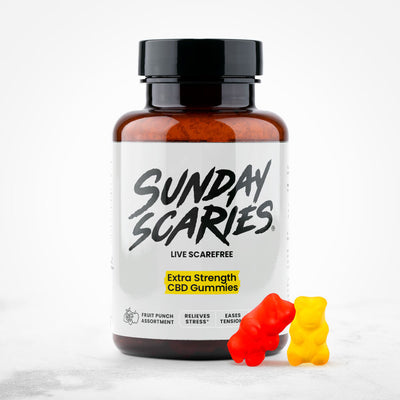 Extra Strength CBD Gummies
Stress Relief
Extra Strength CBD Gummies
Stress Relief
 Vegan CBD Gummies
Stress Relief
Vegan CBD Gummies
Stress Relief
 CBD Gummies for Focus
Focus Boost
CBD Gummies for Focus
Focus Boost
 CBD Candy
Mood Lift
CBD Candy
Mood Lift
 CBD Daytime Oil
Stress Relief
CBD Daytime Oil
Stress Relief
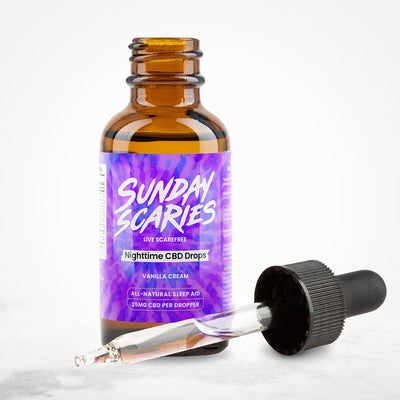 CBD Sleep Oil
Sleep Aid
CBD Sleep Oil
Sleep Aid
 CBD Dog Treats
Stress Relief
CBD Dog Treats
Stress Relief
 Side Piece Bundle
Stress Relief
Side Piece Bundle
Stress Relief
 Rando Bundle
Stress Relief
Rando Bundle
Stress Relief
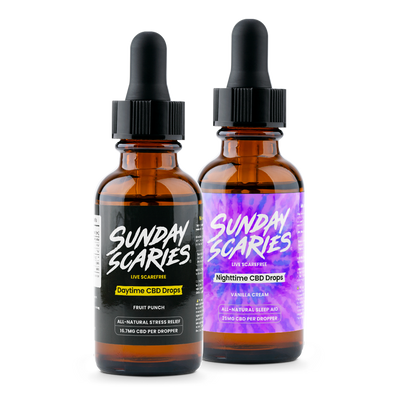 Sunrise & Sunset CBD Oil Bundle
Stress Relief
Sunrise & Sunset CBD Oil Bundle
Stress Relief
 5mg Delta-9 Gummies
Euphoria
5mg Delta-9 Gummies
Euphoria
 10mg Delta-9 Gummies
Euphoria
10mg Delta-9 Gummies
Euphoria
 THC Gummies for Sleep
Sleep Aid
THC Gummies for Sleep
Sleep Aid
 Day & Night THC Gummies Bundle
Stress Relief
Day & Night THC Gummies Bundle
Stress Relief
 Mushroom Gummies
Focus Boost
Mushroom Gummies
Focus Boost
 Shilajit Gummies
Focus Boost
Shilajit Gummies
Focus Boost
 Sunday Scaries Hat
Sunday Scaries Hat
 Sunday Scaries Dad Hat
Sunday Scaries Dad Hat
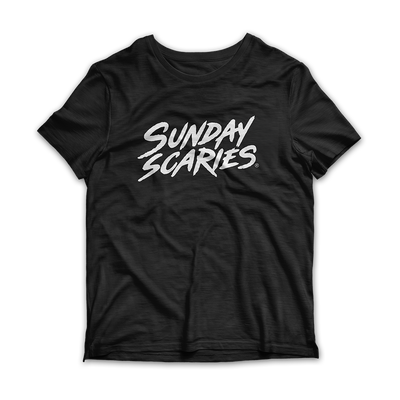 Sunday Scaries T-Shirt
Sunday Scaries T-Shirt
 Sunday Scaries Pocket Tee
Sunday Scaries Pocket Tee
 Sunday Scaries Tank Top
Sunday Scaries Tank Top
 Sunday Scaries Sweatshirt
Sunday Scaries Sweatshirt
 Sunday Scaries Blanket Jacket
Sunday Scaries Blanket Jacket
 Sunday Scaries Sweatpants
Sunday Scaries Sweatpants




